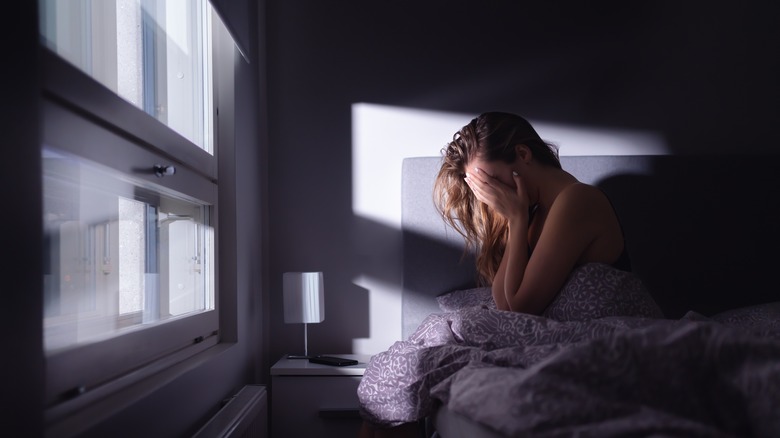For most people, vivid dreams are limited to the realms of the imagination but are often forgotten soon upon waking in the morning. Dreams are often a byproduct of a period of the sleep cycle known as REM, or rapid eye movement, sleep. The Mayo Clinic explains that most individuals spend about 20% of their sleeping time in the stage of sleep where REM occurs.
In a normal sleep cycle progression, movement is not common during REM sleep, as the body is in a stage of natural but temporary paralysis. During this stage of sleep, the blood pressure rises, breathing rates even out, and rapid eye movements occur.
However, WebMD explains that while for most individuals, the physical body is in a state of paralysis, brain activity is high. REM sleep typically begins about 90 minutes into the sleep cycle.
Parasomnias are events or experiences that are both unwanted and unusual and cause disruptions in the sleep cycle (via Cleveland Clinic). One parasomnia that specifically occurs during the REM stage of the sleep cycle is REM sleep behavior disorder.
What is RBD?

REM sleep behavior disorder (RBD) is described as a series of unusual actions or behaviors exhibited while an individual is in the REM stage of sleep. Individuals with RBD will often exhibit aggressive actions or movements, like punching, kicking, or jumping from bed (via WebMD). While most individuals are in a state of paralysis that prevents their body from movement, for individuals with RBD, that natural paralysis is not present. This allows the individual to physically respond to their dreams.
The individual with the condition often does not recognize that they are experiencing the symptoms until someone else, like a sleeping partner, makes them aware of their actions. Obvious vocalizations and movements such as shouting, kicking, sitting up in bed, and flailing are more noticeable symptoms. Subtler signs, such as minor movements or talking, can also occur if an individual is experiencing RBD, according to the Sleep Foundation.
Causes, diagnosis, and treatment
The Mayo Clinic explains that RBD happens when the nerve pathways that typically cause your body to become paralyzed during REM sleep no longer work. Some neurological disorders, like Parkinson’s disease and Lewy body dementia, may be associated with the development of the parasomnia.
Other factors, like taking certain antidepressants or other medications, or alcohol use or withdrawal, can also cause episodes of RBD. Factors like being over 50 and being male also increase the chance of developing RBD (via the Sleep Foundation).
Since the movements can become dangerous or even life-threatening, it’s important to contact your doctor if you are experiencing symptoms of RBD. Diagnosis is typically made after a neurological exam and polysomnographic video recording are conducted, and other potential causes are ruled out (via WebMD).
Treatment for RBD involves a combination of addressing environmental factors that can trigger RBD episodes, medications to help the individual to experience better sleep, and creating a safe and secure sleeping environment (per the Sleep Foundation). Triggers, such as poor sleep hygiene, can increase the potential for RBD episodes, so these should be avoided to the best of one’s ability. Providing a safe sleep environment, such as placing the bed on the floor and removing sharp objects, can ensure that the individual is protected should RBD symptoms develop during the night.